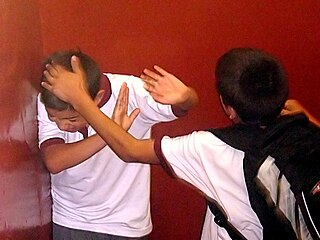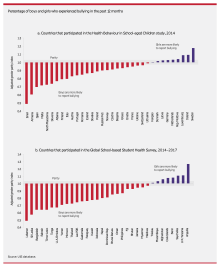
Bullying is the use of force, coercion, hurtful teasing or threat, to abuse, aggressively dominate or intimidate. The behavior is often repeated and habitual. One essential prerequisite is the perception of an imbalance of physical or social power. This imbalance distinguishes bullying from conflict. Bullying is a subcategory of aggressive behavior characterized by hostile intent, imbalance of power and repetition over a period of time.
School violence includes violence between school students as well as attacks by students on school staff. It encompasses physical violence, including student-on-student fighting, corporal punishment; psychological violence such as verbal abuse, and sexual violence, including rape and sexual harassment. It includes many forms of bullying and carrying weapons to school. The one or more perpetrators typically have more physical, social, and/or psychological power than the victim. It is a widely accepted serious societal problem in recent decades in many countries, especially where weapons such as guns or knives are involved.
Relational aggression, alternative aggression, or relational bullying is a type of aggression in which harm is caused by damaging someone's relationships or social status.

School bullying, like bullying outside the school context, refers to one or more perpetrators who have greater physical strength or more social power than their victim and who repeatedly act aggressively toward their victim. Bullying can be verbal or physical. Bullying, with its ongoing character, is distinct from one-off types of peer conflict. Different types of school bullying include ongoing physical, emotional, and/or verbal aggression. Cyberbullying and sexual bullying are also types of bullying. Bullying even exists in higher education. There are warning signs that suggest that a child is being bullied, a child is acting as a bully, or a child has witnessed bullying at school.
Research has found that attempted suicide rates and suicidal ideation among lesbian, gay, bisexual, and transgender (LGBT) youth are significantly higher than among the general population.

Sexual bullying is a form of bullying or harassment in connection with a person's sex, body, sexual orientation or with sexual activity. It can be physical, verbal or emotional in nature, and occurs in various settings, including schools, workplaces, and online platforms. Sexual bullying can have serious and lasting effects on the mental and emotional well-being of victims.
Despite significant progress, education remains a challenge in Latin America. The region has made great progress in educational coverage; almost all children attend primary school and access to secondary education has increased considerably. Children complete on average two more years of schooling than their parents' generation. Most educational systems in the region have implemented various types of administrative and institutional reforms that have enabled reach for places and communities that had no access to education services in the early 90s.
Anti-bullying legislation is a legislation enacted to help reduce and eliminate bullying. This legislation may be national or sub-national and is commonly aimed at ending bullying in schools or workplaces.
Peer victimization is the experience among children of being a target of the aggressive behavior of other children, who are not siblings and not necessarily age-mates.

Historically speaking, lesbian, gay, bisexual, and transgender (LGBT) people have not been given equal treatment and rights by both governmental actions and society's general opinion. Much of the intolerance for LGBT individuals come from lack of education around the LGBT community, and contributes to the stigma that results in same-sex marriage being legal in few countries (31) and persistence of discrimination, such as in the workplace.
Cyberbullying or cyberharassment is a form of bullying or harassment using electronic means. Cyberbullying and cyberharassment are also known as online bullying. It has become increasingly common, especially among teenagers and adolescents, due to the communication technology advancements and young people's increased use of such technologies. Cyberbullying is when someone, typically a teenager, bullies or harasses others on the internet and other digital spaces, particularly on social media sites.
Bullying is abusive social interaction between peers can include aggression, harassment, and violence. Bullying is typically repetitive and enacted by those who are in a position of power over the victim. A growing body of research illustrates a significant relationship between bullying and emotional intelligence.

Conflicts and emergencies around the world pose detrimental risks to the health, safety, and well-being of children. There are many different kinds of conflicts and emergencies, for example, violence, armed conflicts, war, and natural disasters. Some 13 million children are displaced by armed conflicts and violence around the world. Where violent conflicts are the norm, the lives of young children are significantly disrupted and their families have great difficulty in offering the sensitive and consistent care that young children need for their healthy development. One impact is the high rates of PTSD seen in children living with natural disasters or chronic conflict.
Education sector responses to LGBT violence addresses the ways in which education systems work to create safe learning environments for LGBT students. Overall, education sector responses tend to focus on homophobia and violence linked to sexual orientation and gender identity/expression, and less on transphobia. Most responses focus in some way on diverse expressions of gender and support students to understand that gender may be expressed in a different way from binary models. Responses vary greatly in their scope ; duration ; and level of support that they enjoy.
School-related gender-based violence (SRGBV) can be defined as acts or threats of sexual, physical or psychological violence happening in and around schools. This type of violence is due to gender norms and stereotypes. It can include verbal abuse, bullying, sexual abuse, harassment and other types of violence. SRGBV is widely spread around the world and is common in many societies. Millions of children and families suffer from this type of violence. Incidents related to SRGBV has been reported in all countries and regions of the world.
Education sector responses to substance abuse refers to the way in which the education sector strategizes, developments and implements policies and practices that address the use of tobacco, alcohol, and other drugs in educational settings.
School-related gender-based violence in Viet Nam refers to physical, sexual, psychosocial and verbal violence that takes place in the Vietnamese education system. Different forms of School-related gender-based violence (SRGBV) interact and overlap. Bullying, for instance, occurs when there is an imbalance of power between the “bully” and the “bullied” and can happen through physical contact, verbal attacks, social exclusion, and psychological manipulation. Students are bullied when they are repeatedly and intentionally exposed to harmful and/or aggressive behaviour that results in injury or discomfort.
Education in emergencies and conflict areas is the process of teaching and promoting quality education for children, youth, and adults in crisis-affected areas. Such emergency settings include: conflicts, pandemics and disasters caused by natural hazards. Strengthened education systems protects children and youth from attack, abuse, and exploitation, supports peace-building, and provides physical and psychological safety to children. In times of crisis, education helps build resilience and social cohesion across communities, and is fundamental to sustained recovery.

The COVID-19 pandemic has had a considerable impact on female education. Female education relates to the unequal social norms and the specific forms of discrimination that girls face. In 2018, 130 million girls worldwide were out of school, and only two out of three girls were enrolled in secondary education. The COVID-19 pandemic may further widen the gaps and threatens to disrupt the education of more than 11 million girls. In addition, girls are less likely to have access to the Internet and online learning.
The International Day Against Violence and Bullying at School, including Cyberbullying is a UN Educational, Scientific and Cultural Organization (UNESCO) holiday celebrated every year on the first Thursday of November.






